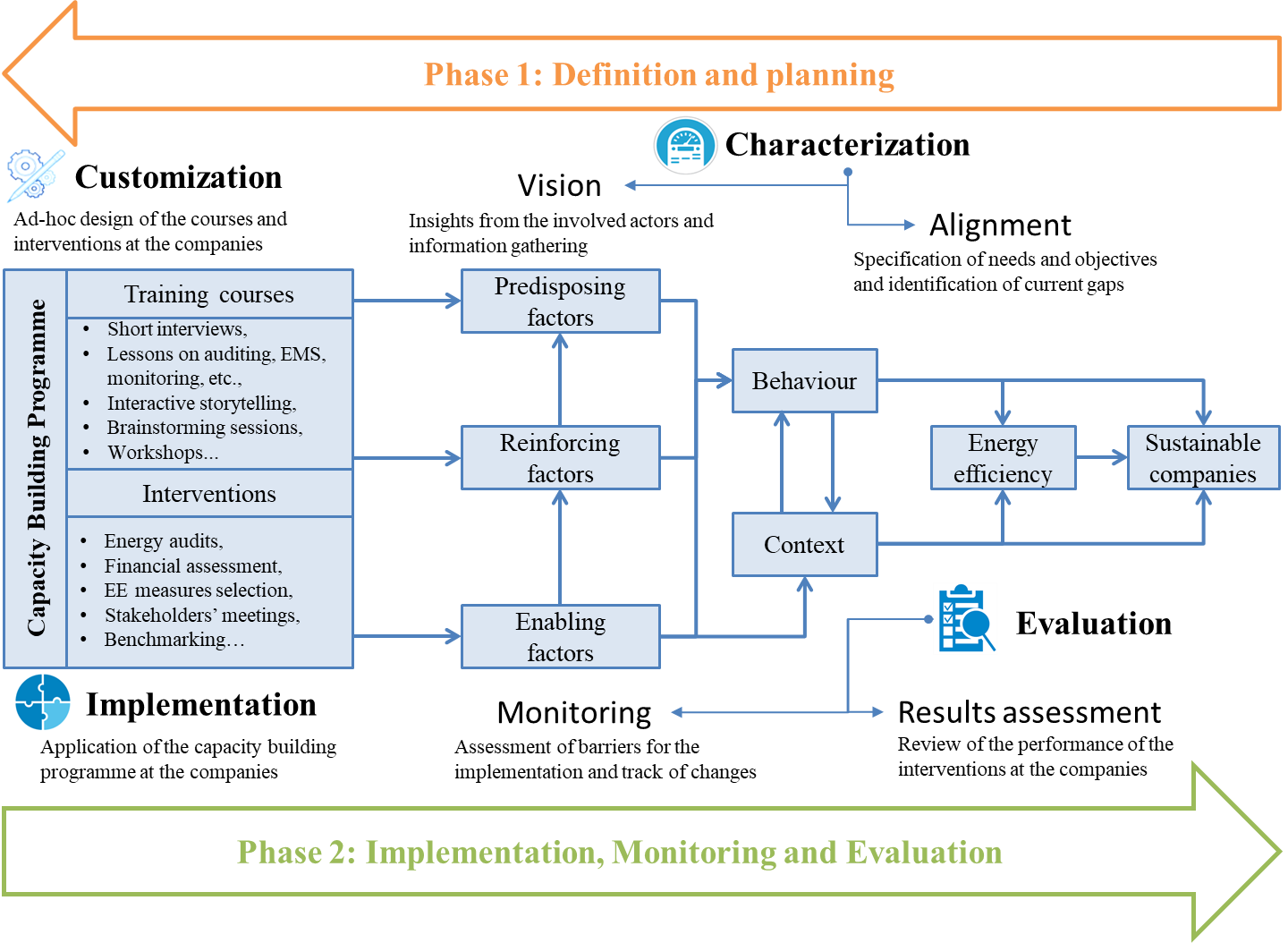E2DRIVER Methodology
The E2DRIVER Methodology is a way of generating and executing capacity building programmes on energy audits and energy efficiency adapted to the needs and interests of companies from the automotive sector. It uses innovative pedagogical approaches, such as Ontological Flip-Teaching and highly interactive exercises and lessons.
This methodology will be materialised as a guide for trainers that will relay the necessary understanding related to the E2DRIVER way of generating customised capacity building programmes for the automotive sector’s SMEs. This guide helps E2DRIVER achieve two goals by:
- providing E2DRIVER trainers with instructions they need in order to implement the E2DRIVER methodology via the E2DRIVER platform.
- producing a handbook for trainers that will enable other trainers to put in practice the methodology of the project in future training actions. Thus, this guide also constitutes a potential replication tool of the project.
The first version of the methodology has already been created. It can be consulted in Deliverable 3.2 – E2DRIVER Training Methodology. The final version of this methodology is expected to be generated once the pilot phase is finished (second half of 2021).
The E2DRIVER methodology is composed of four steps: Characterization, customization, implementation and evaluation, all needing the support of the E2DRIVER Platform for their implementation.

E2DRIVER methodology
Characterization
- Provision of a benchmarking analysis.
- Alignment with the companies needs and expectations.
- Measurement and analysis of the current situation of trained companies.
- Identification of profiles within the company.
In this first step, E2DRIVER collects information about the automotive sector, the companies and previous training programmes, seeking to collect the needed inputs in order to adapt trainings to each company and profile, depending on their needs and interests.
Customization
- Adaptation to the requirements and specifications of companies.
- Development of specific training plan itineraries.
- Selection of training materials of relevance for each profile.
- Definition of the overall implementation plan and itinerary.
Considering available training materials and company / profile needs and interest, the customization process is performed.
Implementation
- Engagement of trainees from the company staff.
- Implementation of introductory sessions and lessons.
- Implementation of the specific training.
- Implementation of interactive workshops.
Ones the itineraries are defined for each company and profile, the training are implemented.
Evaluation
- Review the proposed training and actions implemented.
- Facilitate the use of the project tools.
- Introduction of improvements and methodology updating.
- Feedback to the E2DRIVER platform and materials.
Finally, the assessment of the trainings and their impacts is performed, whereafter the inputs that improve the training, the methodology and the materials are obtained.
Customisation of the training
The E2DRIVER Methodology is based on customising environments, which enables an easy adaptation of the training to the different scenarios and needs of each company and profile. The whole Methodology design is focused on the design of a customisation scheme where needs and expectations of trainees are considered.
The training customisation process will be implemented via the E2DRIVER platform. Right after accessing the platform and verifying their account, each trainee will be required to fill out a classification survey that will inquire about his or her background information. The survey will achieve two things:
- It will classify trainees into a training path specific to the input provided in the survey. Training paths exist for: managers, scientific and engineering professionals, technical managers and change agents.
- It will determine which learning materials are most appropriate for trainees. They will be broadly classified into compulsory and optional learning materials.
After unlocking the appropriate training path, trainees will be able to go through the course sections and engage with the training content.
For more information: consult Deliverable 3.2
Ontological Flip Teaching
Pedagogically speaking, the E2DRIVER project utilises Ontological Flip-Teaching as the main approach for conducting the trainings.
This approach is founded on the idea that individual experience and knowledge are able to become collective if managed properly. For that reason, this paradigm has ideated a whole process that enables the socialisation of trainees and, consequently, the generation of “explicit” knowledge that could positively impact the collective intelligence of a group.
To do so, the Ontological Flip Teaching approach divides the training into three main dimensions:
- Trainees will learn the theoretical contents on their own using the E2DRIVER platform
- They are expected to create academic work connected to the topic of the training
- They will participate in an on-site training where they will perform exercises, clarify doubts and use the Virtual Reality solution generated by the project
For more information: consult the Deliverable 3.2 and the article à Fidalgo-Blanco, Á., Sein-Echaluce, M. L., & García-Peñalvo, F. J. (2018). Ontological flip teaching: A flip teaching model based on knowledge management. Universal Access in the Information Society, 17(3), 475–489. doi:10.1007/s10209-017-0556-6
Virtual Reality Modules
The innovative aspect of the E2DRIVER training is not only linked to the methodology of the project, but also to the use of the latest technologies in this field, such as virtual reality. The objective is to allow trainees to learn about the energy audit context and other aspects connected with energy efficiency in companies in a virtual scenario.